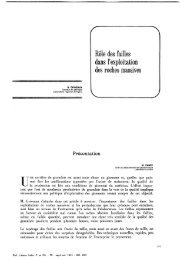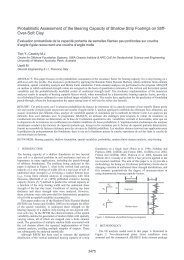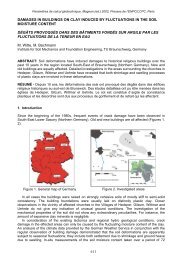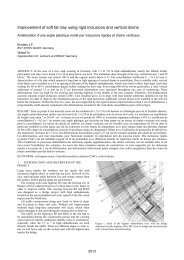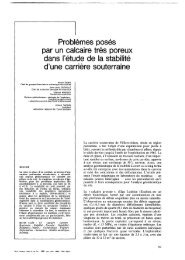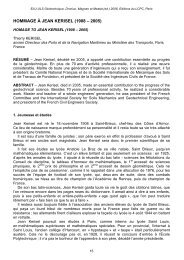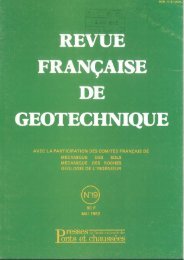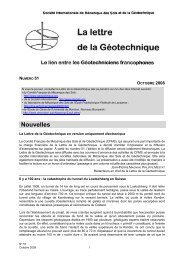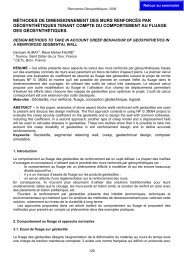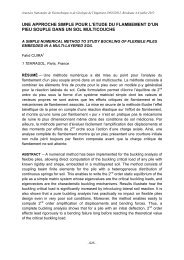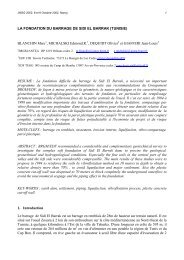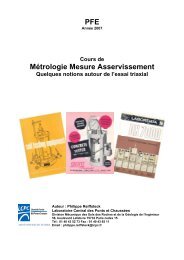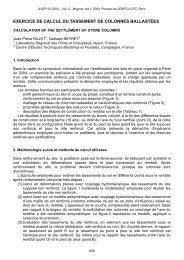THE VIBRATORY PILE INSTALLATION TECHNIQUE - Viking
THE VIBRATORY PILE INSTALLATION TECHNIQUE - Viking
THE VIBRATORY PILE INSTALLATION TECHNIQUE - Viking
You also want an ePaper? Increase the reach of your titles
YUMPU automatically turns print PDFs into web optimized ePapers that Google loves.
to the three above mentioned engineering issues, which is further addressed in section ‘Choiceof vibratory driver related parameters’.2. Modern vibratory driving equipmentThere are two types of modern vibratory-equipment commercially available, and these are ‘freehanging’ and ‘leader mounted’ systems. Hydraulic vibratory driving equipment predominates themarket because they are both lighter in weight compared to electrical, and hydraulic allows bothfrequency as well as eccentricity adjustments. Advantages with free-hanging systems includelower costs and grater reach. In addition, they can also be more beneficial when bearingcapacity of the underlying soil is low. Built in limitations are lack of both controlling and guidingthe pile to desired position, as well as changing the static surcharge force during the installation.The built in advantages of the leader-mounted system enables the system to operate withgreater precision with respect to positioning, displacement amplitude, as well as driving andextracting forces. Drawbacks are usually costs together with weight, which can cause stabilityproblem at the construction site. However, the main parts of leader-mounted equipments areessentially the same as free hanging systems, and consist of the following parts, (see Fig. 1).- Power source; normally a basic hydraulic power pack containing necessary components toboth power and control the equipment.- Power transmission; high-pressure hydraulic hoses and electrical cables for signal andsensor control.- The vibro-unit; is the part of the equipment that generates the sinusoidal motion of the pileprofile, and finally.- The pile profile; intended to be installed.Both ‘free hanging’ and ‘leader mounted’ systems can be equipped with different type of vibrounits.However, vibro-units used for ‘free hanging’ are normally constructed with rotatingeccentric weights laid horizontally, and ‘leader mounted’ normally has their rotating eccentricweights stacked vertically, with main reason to make them less bulky and to be able to raise theunit along the leader without stability problems.2.1. Mechanical action of vibratory drivers/extractorsThe generated driving force F d governs the mechanical action of a vibratory driver, which in turnconsist of the two parts; a stationary part F o and a dynamic part F v , schematically illustrated byfigure 2. The in time stationary part F o (further explained below), and the dynamic part F vgoverned by the counter-rotating eccentric masses within the exciter block of the vibro-unit.The generated driving force F d = F o + F v , (imparted to the pile head), is governed by thefollowing ‘vibro-related parameters’.2.1.1. Surcharge forceF o is in the case of a "free-hanging" vibro represented by the sum of the dead weight of the biasmass W, minus the suspension force T of the carrier (crane), according to F o =W-T, (see Fig. 5).The surcharge force of a "leader mounted" vibro consist of the dead weight of the bias mass W,plus/minus the hydraulically applied pre-stress/tension force P=P o A cyl , which is controlled by thehydraulic pressure P o generated on the area A cyl of leader cylinder II, (see Fig. 1), according toF o =W±P.2.1.2. Eccentric momentM e is given in pound-inch [kg-m] and computed by the product of the eccentric weight W e [kg]and the radius of gyration r e [m] (i.e. distance between centre of the motor shafts and thegravity centre of the rotating eccentric weight).67



